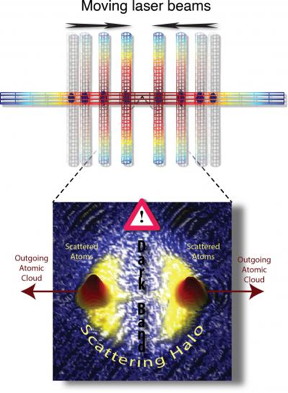Home > Press > Physicists collide ultracold atoms to observe key quantum principle
 |
| University of Otago physicist Niels Kjærgaard and his team have used extremely precisely controlled laser beams to confine, accelerate and gently collide ultracold atomic clouds of fermionic potassium.
This allowed them to directly observe a key principle of quantum theory, the Pauli Exclusion Principle. This principle predicts a forbidden zone along a meridian of the spherical halo of scattered particles, which the Otago experiments indeed unveiled. The dark band in the graphic shows a rule derived from the principle in action. This rule is that indistinguishable fermions cannot scatter out at 90 degrees to the collision axis. CREDIT: Niels Kjærgaard |
Abstract:
Physicists from New Zealand's University of Otago have used steerable 'optical tweezers' to split minute clouds of ultracold atoms and slowly smash them together to directly observe a key theoretical principle of quantum mechanics.
Physicists collide ultracold atoms to observe key quantum principle
Dunedin, New Zealand | Posted on July 13th, 2016The principle, known as Pauli Exclusion, places fundamental constraints on the behavior of groups of identical particles and underpins the structure and stability of atoms as well as the mechanical, electrical, magnetic and chemical properties of almost all materials.
Otago Physics researcher Associate Professor Niels Kjærgaard led the research, which is newly published in the prestigious journal Nature Communications.
Kjærgaard and his team used extremely precisely controlled laser beams to confine, accelerate and gently collide ultracold atomic clouds of fermionic potassium. The atomic clouds had a temperature of a mere millionth of degree Kelvin above absolute zero.
The Pauli Exclusion Principle predicts a forbidden zone along a meridian of the spherical halo of scattered particles, which the experiments indeed unveiled.
"This dark band results from a 'no side-stepping' rule that the principle dictates, which is that indistinguishable fermions cannot scatter out at 90 degrees to the collision axis," Kjærgaard says.
When PhD student Ryan Thomas looked more closely at his data, he found that under some conditions the images of scattering halos from the particles would actually display side-stepping--the dark band would be less dark.
"This is not because the rule suddenly breaks down, but because there can be situations where a particle scatters multiple times with consecutively new collision axes," Associate Professor Kjærgaard says.
This particular finding has important implications for gaining insights into the particulars of the underlying processes governing multiple particle scattering.
###
The work was supported by the Marsden Fund of New Zealand.
####
For more information, please click here
Contacts:
Niels Kjærgaard
Copyright © University of Otago
If you have a comment, please Contact us.Issuers of news releases, not 7th Wave, Inc. or Nanotechnology Now, are solely responsible for the accuracy of the content.
| Related Links |
| Related News Press |
News and information
![]() Researchers develop molecular qubits that communicate at telecom frequencies October 3rd, 2025
Researchers develop molecular qubits that communicate at telecom frequencies October 3rd, 2025
![]() Next-generation quantum communication October 3rd, 2025
Next-generation quantum communication October 3rd, 2025
![]() "Nanoreactor" cage uses visible light for catalytic and ultra-selective cross-cycloadditions October 3rd, 2025
"Nanoreactor" cage uses visible light for catalytic and ultra-selective cross-cycloadditions October 3rd, 2025
Quantum Physics
![]() ICFO researchers overcome long-standing bottleneck in single photon detection with twisted 2D materials August 8th, 2025
ICFO researchers overcome long-standing bottleneck in single photon detection with twisted 2D materials August 8th, 2025
![]() Quantum computers simulate fundamental physics: shedding light on the building blocks of nature June 6th, 2025
Quantum computers simulate fundamental physics: shedding light on the building blocks of nature June 6th, 2025
![]() A 1960s idea inspires NBI researchers to study hitherto inaccessible quantum states June 6th, 2025
A 1960s idea inspires NBI researchers to study hitherto inaccessible quantum states June 6th, 2025
Discoveries
![]() Researchers develop molecular qubits that communicate at telecom frequencies October 3rd, 2025
Researchers develop molecular qubits that communicate at telecom frequencies October 3rd, 2025
![]() Next-generation quantum communication October 3rd, 2025
Next-generation quantum communication October 3rd, 2025
![]() "Nanoreactor" cage uses visible light for catalytic and ultra-selective cross-cycloadditions October 3rd, 2025
"Nanoreactor" cage uses visible light for catalytic and ultra-selective cross-cycloadditions October 3rd, 2025
Announcements
![]() Rice membrane extracts lithium from brines with greater speed, less waste October 3rd, 2025
Rice membrane extracts lithium from brines with greater speed, less waste October 3rd, 2025
![]() Researchers develop molecular qubits that communicate at telecom frequencies October 3rd, 2025
Researchers develop molecular qubits that communicate at telecom frequencies October 3rd, 2025
![]() Next-generation quantum communication October 3rd, 2025
Next-generation quantum communication October 3rd, 2025
![]() "Nanoreactor" cage uses visible light for catalytic and ultra-selective cross-cycloadditions October 3rd, 2025
"Nanoreactor" cage uses visible light for catalytic and ultra-selective cross-cycloadditions October 3rd, 2025
Interviews/Book Reviews/Essays/Reports/Podcasts/Journals/White papers/Posters
![]() Spinel-type sulfide semiconductors to operate the next-generation LEDs and solar cells For solar-cell absorbers and green-LED source October 3rd, 2025
Spinel-type sulfide semiconductors to operate the next-generation LEDs and solar cells For solar-cell absorbers and green-LED source October 3rd, 2025
![]() Rice membrane extracts lithium from brines with greater speed, less waste October 3rd, 2025
Rice membrane extracts lithium from brines with greater speed, less waste October 3rd, 2025
|
|
||
|
|
||
| The latest news from around the world, FREE | ||
|
|
||
|
|
||
| Premium Products | ||
|
|
||
|
Only the news you want to read!
Learn More |
||
|
|
||
|
Full-service, expert consulting
Learn More |
||
|
|
||








